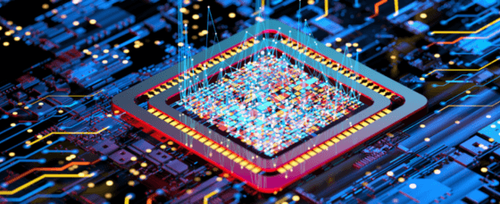Power Players in Generative AI
Ankita Rai
Fri 23 Jun 2023 5 minutesThe widespread adoption of the conversational chatbot ChatGPT has triggered a gold rush among tech giants. Alphabet, Microsoft, Baidu, and Meta have all swarmed in to capitalise on generative AI technologies capable of creating texts, images, videos, audios, and even software codes.
But investing in generative AI is not as simple as picking the right tech trend, like the cloud, electric vehicles, or blockchain. There is a long value chain to consider.
Amongst the prominent players in this race, NVIDIA recently became the first chip company to surpass a trillion-dollar market value, joining Apple, Alphabet, Microsoft, and Amazon.
The stock has gained 200 per cent since October last year.
The reason behind NVIDIA's meteoric rise is its expertise in supplying the right "picks and shovels" to enable the broader market to keep up with fast growing AI demand—that is semiconductors designed for AI servers.
NVIDIA is not the sole beneficiary. It mirrors a broader trend across the industry, with many players such as C3.ai, AMD, TSMC, and Arista capitalising on the growing opportunities.
The generative AI value chain introduced
Let’s introduce the major players in the AI value chain…
1.Semiconductor companies: Powering generative AI models
Generative AI requires powerful computing networks capable of performing numerous simultaneous computations. Semiconductors, specifically graphics chips, are essential for training generative AI models.
NVIDIA dominates the growing generative AI field with its powerful H100 chip architecture, which is behind AI chatbots like ChatGPT and Bard. By 2027, the market for these chips is expected to grow to $60 billion. NVIDIA is the market leader with more than 75 per cent market share.
AMD also shows promise with its latest release of AI chips made for deploying AI models.
One step down the value chain is Taiwan Semiconductor Manufacturing Company (TSMC), which makes chips for Nvidia, AMD and Apple. Last week TSMC regained its US$500billion market capitalisation thanks to high demand for its AI chips.
2.AI networking technology suppliers
Generative AI is likely to be the most significant growth driver in the network switch market. Research firm 650 Group estimates AI networking will surpass $10 billion in revenue by 2027.
Network switches play a crucial role in facilitating communication within the AI infrastructure by enabling high-speed and reliable connections between AI servers, storage systems, and data sources.
NVIDIA, Arista, Cisco Systems and Juniper Networks are some of the biggest names in the space. Microsoft, Open AI's investor and technology partner, and Meta are among Arista's top customers.
3. Cloud services providers
Cloud service providers form the backbone of generative AI infrastructure. Generative AI models require GPUs that are highly efficient at parallel processing, which cloud service providers provide on-demand.
It is no coincidence that the key players in the generative AI race are cloud hyper-scalers including Amazon AWS, Google Cloud, and Microsoft Azure.
However, these alone cannot meet the demand for AI computing. There has also been a proliferation of cloud startups supplying AI infrastructure alongside NVIDIA, IBM, and Equinix who are offering GPUs "as a service".
Recent funding rounds highlight this trend, with Lambda raising $44m for an AI cloud operation and CoreWeave securing $221m backed by Nvidia.
4. Data centres
Among key AI infrastructure players, data centres are the closest to providing the actual shovels. These players might even be the most underrated AI investment play.
Increasing data usage and improved computing efficiency will fuel the demand for data centres. According to JLL, the global data centre market is expected to double from $359.5 billion in 2022 to $739.5 billion in 2027.
Specialists such as Equinix, DigitalBridge and Digital Realty, compete with big players like Alphabet, Amazon and Microsoft in the space.
5. Applications
Generative AI capabilities will increasingly be built into the software we use every day, with costs ranging from a few thousand to millions of dollars for customised services built on licensed and proprietary models.
Microsoft, Adobe, and Salesforce have already launched generative AI in their mainstream applications. Canva has also announced new AI-powered design tools to assist users.
This is just the beginning. An S&P Global Market Intelligence report predicts revenues from generative AI offerings will reach $36 billion by 2028, rising at a compound annual growth rate of 58 per cent.
Explore 100's of investment opportunities and find your next hidden gem!
Search and compare a purposely broad range of investments and connect directly with product issuers.
Key takeaways for investors:
AI as an investment theme is here to stay, and there are many ways for investors to gain access. Here are three key takeaways for investors…
1.Investing in generative AI is not as simple as picking the best technology. There is a long value chain to consider.
2.Specialised AI chips and companies providing AI infrastructure are among the emerging leaders in the space.
3.Generative AI applications is the fastest growing segment. Companies using proprietary data for customised services will have a competitive edge.
Disclaimer: This article is prepared by Ankita Rai. It is for educational purposes only. While all reasonable care has been taken by the author in the preparation of this information, the author and InvestmentMarkets (Aust) Pty. Ltd. as publisher take no responsibility for any actions taken based on information contained herein or for any errors or omissions within it. Interested parties should seek independent professional advice prior to acting on any information presented. Please note past performance is not a reliable indicator of future performance.







